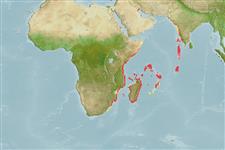>
Acropomatiformes (Oceanic basses) >
Pempheridae (Sweepers)
Etymology: Parapriacanthus: Greek, para = near + Greek, prion = saw + Greek, akantha = thorn (Ref. 45335); punctulatus: Name from Latin 'punctulatus' for dotted; referring to the profusion of dark dots on the side of the body below the lateral line that extend well posterior to the origin of the anal fin; these dots are more evident on preserved specimens than in life..
Environment: milieu / climate zone / depth range / distribution range
Écologie
marin récifal; profondeur 16 - 61 m (Ref. 107896). Tropical
Distribution
Pays | Zones FAO | Écosystèmes | Occurrences | Point map | Introductions | Faunafri
Western Indian Ocean: wide-ranging from South Africa (KwaZulu-Natal) and Mozambique to the Comoro Islands, northern Madagascar, Seychelles, the Mascarene Ridge, and the Mascarene Island of Réunion.
Taille / Poids / Âge
Maturity: Lm ? range ? - ? cm
Max length : 6.7 cm SL mâle / non sexé; (Ref. 107896); 5.0 cm SL (female)
Description synthétique
Morphologie | Morphométrie
Épines dorsales (Total): 6; Rayons mous dorsaux (Total): 9; Épines anales 3; Rayons mous anaux: 20 - 23. This species is characterized by the following: D VI,9; A III,21 (20-23); pectoral-fin rays 16 (15-17); lateral-line scales 69 (63-72); scale rows above lateral line to base of dorsal fin 5.5; gill rakers 24 (23-26, modally 25); body depth 3.2 (3.25-3.35) in SL, width 2.1 (2.0-2.2) in body depth; depth of caudal-peduncle 10.4 (8.9-9.6) in SL; head length 2.95 (2.8-2.9) in SL; snout length 11.4-13.0 in SL; mouth forming an angle of about 60° to horizontal axis of body; sharply conical, recurved teeth in 2 irregular rows in upper row more forward-projecting, those of second row more strongly recurved; similar smaller teeth in lower jaw, well-spaced, in a single row; very small, incurved, sharply conical teeth in a single irregular row on vomer and palatines; thin lips, covered with closely adjacent papillae; tongue broadly triangular, indented indented on side near tip, forming a small, half-round, flexible flap; predorsal length 2.3 (2.3-2.4) in SL; first dorsal-fin soft ray is longest, 5.3 (4.7-5.4) in SL; caudal fin forked with fin length 4.5 (3.6-4.3) in SL; pectoral-fin length 3.5 (3.25-3.6) in SL; prepelvic length 2.7 (2.5-2.7) in SL; pelvic fins not reaching the anus, fin length 5.9 (5.1-6.5) in SL; preanal length 1.5 (1.5-1.6) in SL; without a pin-like dark line anterior to anus; instead a very dark blue band with a median dull pink streak that narrows anteriorly; black iris in preserved holotype (Ref. 107896).
Stomach contents include a half-digested polychaete about 45 mm by 5 mm, along with copepods, crustacean larvae, and small fishes (Ref. 107896).
Life cycle and mating behavior
Maturité | Reproduction | Frai | Œufs | Fécondité | Larves
Randall, J.E. and S.V. Bogorodsky, 2016. Preliminary review of the pempherid fish genus Parapriacanthus of the western Indian Ocean, with descriptions of five new species. J. Ocean Sci. Found. 20:1-24. (Ref. 107896)
Statut dans la liste rouge de l'IUCN (Ref. 130435)
Menace pour l'homme
Harmless
Utilisations par l'homme
Plus d'informations
PaysZones FAOÉcosystèmesOccurrencesIntroductionsStocksÉcologieRégime alimentaireÉléments du régime alimentaireConsommation alimentaireRation
Noms communsSynonymesMétabolismePrédateursÉcotoxicologieReproductionMaturitéFraiRassemblement de ponteFéconditéŒufsDéveloppement de l'œuf
Taille/ÂgeCroissanceLongueur-poidsLongueur-longueurFréquences de longueursMorphométrieMorphologieLarvesDynamique des populations larvairesRecrutementAbondanceBRUVS
RéférencesAquacultureProfil d'aquacultureSouchesGénétiqueElectrophoresesHéritabilitéPathologiesTraitementNutrientsMass conversion
CollaborateursImagesStamps, Coins Misc.SonsCiguateraVitesseType de nageSurface branchialeOtolithesCerveauxVision
Outils
Articles particuliers
Télécharger en XML
Sources Internet
Estimates based on models
Phylogenetic diversity index (Ref.
82804): PD
50 = 0.5005 [Uniqueness, from 0.5 = low to 2.0 = high].
Bayesian length-weight: a=0.01479 (0.00642 - 0.03409), b=3.02 (2.82 - 3.22), in cm total length, based on LWR estimates for this (Sub)family-body shape (Ref.
93245).
Niveau trophique (Ref.
69278): 3.3 ±0.4 se; based on size and trophs of closest relatives
Résilience (Ref.
120179): Haut, temps minimum de doublement de population inférieur à 15 mois (Preliminary K or Fecundity.).
Fishing Vulnerability (Ref.
59153): Low vulnerability (10 of 100).
